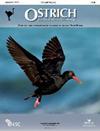栖息地丧失和破碎化对南非特有的Agulhas长嘴Lark Certhilauda brevicostris种群最新估计的影响
IF 1.1
4区 生物学
Q2 ORNITHOLOGY
引用次数: 1
摘要
Agulhas长嘴Lark Certhilauda brevicostris是南非特有种,仅限于南非西南角Agulhas平原的fynbos栖息地。为南非准备的1990年、2014年和2018年土地利用土地覆盖(LULC)数据库用于使用β回归确定最能描述这种鸟合适栖息地的LULC类别。先前公布的Agulhas长嘴Lark的密度和LULC类别的表面积被认为是鸟类的合适栖息地,用于估计其历史和当前的种群规模,以及鸟类种群的变化率。贝塔回归模型是根据该鸟调整后的报告率和总表面积以及其他三个景观指标编制的,这些指标被认为是适合它们的栖息地。这些模型表明,尽管Agulhas长嘴Lark因其天然fynbos栖息地的丧失而受到不利影响,但这些不利影响已被夏季休耕地的增加所抵消。这证实了之前的观察结果,即农业可能使阿古拉斯长嘴云雀的数量增加。Agulhas Long billed Lark的发生范围(EOO)估计为1322509公顷(n=197个五分之一),2020年的入住面积(AOO)预计为1076854公顷。据估计,在三代人(10.5年)的时间里,这些鸟类的栖息地减少了3.5%。本研究对阿古拉斯长嘴云雀的种群数量进行了改进,估计数量在146 344至264 691只之间,自然栖息地中有60 753至109 883只,改造栖息地中有85 591至154 808只。本研究的结果表明,阿古拉斯长嘴云雀的近危状态需要重新审视。本文章由计算机程序翻译,如有差异,请以英文原文为准。
The effects of habitat loss and fragmentation on updated estimates of the population of the Agulhas Long-billed Lark Certhilauda brevirostris, a South African endemic
The Agulhas Long-billed Lark Certhilauda brevirostris is a South African endemic and is restricted to the fynbos habitat of the Agulhas Plain in the southwestern corner of South Africa. The 1990, 2014, and 2018 land use land cover (LULC) databases prepared for South Africa were used to determine the LULC categories that best describe suitable habitat for this bird using beta regressions. Previously published densities of Agulhas Long-billed Lark and the surface area of the LULC categories considered suitable habitat for the birds were used to estimate their historical and current population sizes, and the rates of change in the bird’s population. Beta regression models were compiled from the bird’s adjusted reporting rate and the total surface area, and three other landscape metrics, of the per pentad LULC categories considered suitable habitat for them. These models revealed that although the Agulhas Long-billed Lark is adversely affected by the loss of its natural fynbos habitat these adverse effects have been offset by an increase in the availability of fallow fields in summer. This confirms previous observations that agriculture may have allowed the Agulhas Long-billed Lark to increase in numbers. The Agulhas Long-billed Lark’s extent of occurrence (EOO) was estimated at 1 322 509 ha (n = 197 pentads) with an area of occupancy (AOO) estimated to be 1 076 854 ha in 2020. The decline in habitat available to the birds was estimated to be 3.5% over three generations (10.5 years). The present study provides improved estimates of the population of the Agulhas Long-billed Lark of between 146 344 and 264 691 individuals, with between 60 753 and 109 883 individuals in natural habitat, and between 85 591 and 154 808 individuals in transformed habitat. The results of the present study indicate that the Agulhas Long-billed Lark’s Near Threatened status should be reviewed.
求助全文
通过发布文献求助,成功后即可免费获取论文全文。
去求助
来源期刊

Ostrich
生物-鸟类学
CiteScore
2.10
自引率
30.00%
发文量
24
审稿时长
>12 weeks
期刊介绍:
Ostrich: Journal of African Ornithology is the leading ornithological journal in Africa, and publishes peer-reviewed scientific papers and short communications (
 求助内容:
求助内容: 应助结果提醒方式:
应助结果提醒方式:


